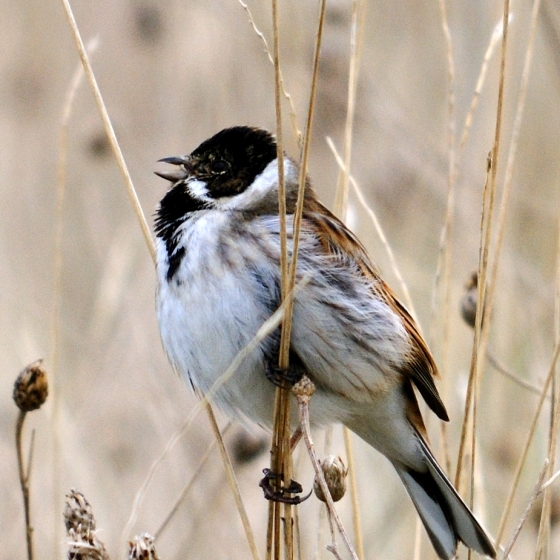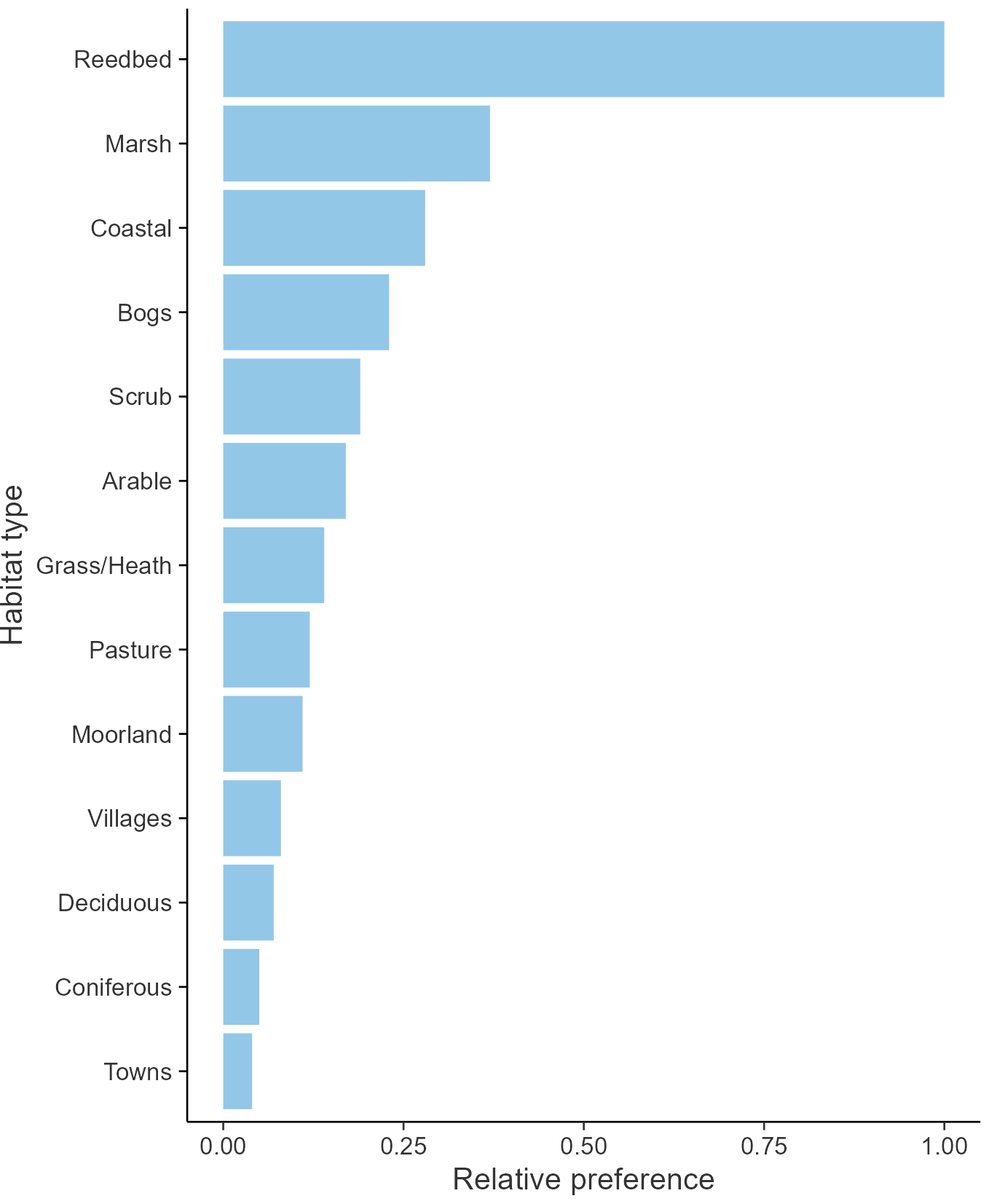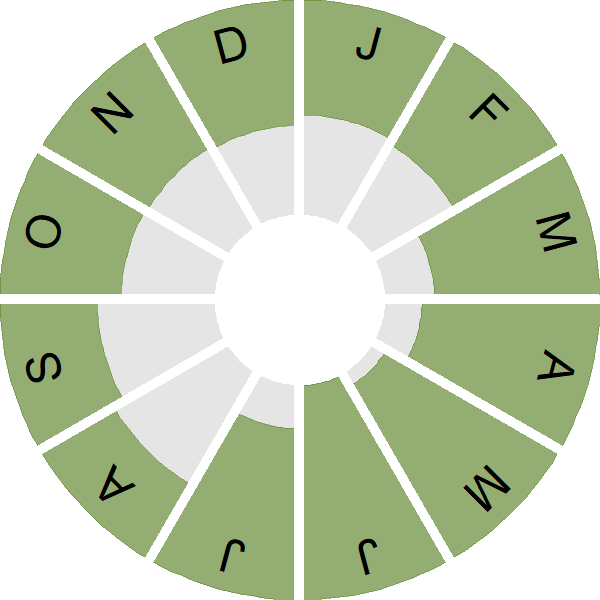Reed Bunting

Introduction
Not just a bird of reedbeds, this common species is widely distributed across much of Britain & Ireland throughout the year. It is absent only from the highest upland areas.
The male Reed Bunting has a striking black head with a white moustachial stripe; the female has a browner head, but the moustachial stripe is still visible. When perched, both sexes flirt their tail sideways, showing white outer feathers. The male's buzzing call is distinctive.
In winter, the Reed Bunting often joins other finches and buntings to feed in arable landscapes. At the end of the 20th century, BTO research attributed declines in these species to intensive agriculture reducing food availability over the winter months. This issue has been, to some extent, addressed through agri-environment schemes, and there has been a gradual overall increase in the UK population since the late-1990s. However, the picture is mixed with a significant decline in South-east England.
- Our Trends Explorer gives you the latest insight into how this species' population is changing.

Key Stats
Identification
ID Videos
This section features BTO training videos headlining this species, or featuring it as a potential confusion species.
Sparrows
Winter buntings
Songs and Calls
Song:
Call:
Status and Trends
Conservation Status
Population Change
Reed Bunting abundance has fluctuated without a clear trend since the 1980s. The long-term WBS/WBBS trend shows a large decline and raises an alert, contrasting with the long-term CBC/BBS trend. However, the CBC/BBS trend shows a substantial increase in the first eight years until the mid-1970s followed by a substantial decline in the late 1970s and early 1980s, and therefore the trends would be consistent if they had both started in 1975. Results from BBS indicate significant population increase since 1995, though with a downturn from around 2008 to 2012. The BBS map of change in relative density between 1994-96 and 2007-09 indicates that increase over that period was widespread, but strongest in northeastern England, while decrease had occurred in Northern Ireland, Orkney and the far southeast. The initial decline placed Reed Bunting on the red list but in 2009, with evidence from BBS of some recovery in numbers, the species was moved from red to amber. There has been a decline across Europe since 1980 (PECBMS: PECBMS 2020a>).
Distribution
Breeding Reed Buntings are widely distributed across Britain and Ireland with gaps confined to the more barren uplands of northern Scotland, including Shetland and some Hebridean islands. Highest densities are associated mostly with large lowland vales and plains. Reed Buntings are mostly sedentary and distribution patterns in winter and the breeding season differ only where birds abandon upland areas in winter.
Occupied 10-km squares in UK
2007/08–10/11
or view it on Bird Atlas Mapstore.
2008–11
or view it on Bird Atlas Mapstore.
European Distribution Map
Distribution Change
The breeding distribution has been largely stable since the 1968–72 Breeding Atlas, despite a major population increase and subsequent decline in the 1970s. More recently, increases in abundance are apparent in eastern and northeast England and in southern Scotland, whilst declines are concentrated into southeast England. Some declines are also apparent in eastern Ireland.
Change in occupied 10-km squares in the UK
from 1981–84 to 2007–11
or view it on Bird Atlas Mapstore.
from 1968–72 to 2008–11
or view it on Bird Atlas Mapstore.
Seasonality
Reed Bunting is recorded throughout the year, with detections peaking at 20% of complete lists in summer when easily detected by song.
Weekly pattern of occurrence
The graph shows when the species is present in the UK, with taller bars indicating a higher likelihood of encountering the species in appropriate regions and habitats.

Habitats
Breeding season habitats
Relative frequency by habitat
The graph shows the habitats occupied in the breeding season, with the most utilised habitats shown at the top. Bars of similar size indicate the species is equally likely to be recorded in those habitats.

Movement
Britain & Ireland movement
Foreign locations of birds ringed or recovered in Britain & Ireland
Dots show the foreign destinations of birds ringed in Britain & Ireland, and the origins of birds ringed overseas that were subsequently recaptured, resighted or found dead in Britain & Ireland. Dot colours indicate the time of year that the species was present at the location.
- Winter (Nov-Feb)
- Spring (Mar-Apr)
- Summer (May-Jul)
- Autumn (Aug-Oct)

European movements
EuroBirdPortal uses birdwatcher's records, such as those logged in BirdTrack to map the flows of birds as they arrive and depart Europe. See maps for this species here.
The Eurasian-African Migration Atlas shows movements of individual birds ringed or recovered in Europe. See maps for this species here.
Biology
Productivity and Nesting
Nesting timing
Egg measurements
Clutch Size
Incubation
Fledging
Survival and Longevity
Survival is shown as the proportion of birds surviving from one year to the next and is derived from bird ringing data. It can also be used to estimate how long birds typically live.
View number ringed each year in the Online Ringing Report.
Lifespan
Survival of adults
Survival of juveniles
Biometrics
Wing length and body weights are from live birds (source).
Wing length
Body weight
Ring Size
Classification, names and codes
Classification and Codes
- Order: Passeriformes
- Family: Emberizidae
- Scientific name: Emberiza schoeniclus
- Authority: Linnaeus, 1758
- BTO 2-letter code: RB
- BTO 5-letter code: REEBU
- Euring code number: 18770
Alternate species names
- Catalan: repicatalons
- Czech: strnad rákosní
- Danish: Rørspurv
- Dutch: Rietgors
- Estonian: rootsiitsitaja
- Finnish: pajusirkku
- French: Bruant des roseaux
- Gaelic: Gealag-dhubh-cheannach
- German: Rohrammer
- Hungarian: nádi sármány
- Icelandic: Seftittlingur
- Irish: Gealóg Ghiolcaí
- Italian: Migliarino di palude
- Latvian: niedru sterste, svilspraklitis
- Lithuanian: nendrine starta
- Norwegian: Sivspurv
- Polish: potrzos (zwyczajny)
- Portuguese: escrevedeira-dos-caniços
- Slovak: strnádka trstinová
- Slovenian: trstni strnad
- Spanish: Escribano palustre
- Swedish: sävsparv
- Welsh: Bras Cyrs
- English folkname(s): Reed/Fen Sparrow
Research
Causes of Change and Solutions
Causes of change
Detailed demographic analyses suggest that the decline was driven by decreasing survival rates and that a subsequent population recovery may have been prevented by increased nest losses.
Further information on causes of change
The early increase in the CBC index was associated with a gradual spread into drier habitats, especially farmland, and it is likely that the subsequent decline was related to agricultural intensification. Detailed demographic analyses suggest that the decline was driven by decreasing survival rates and that a subsequent population recovery may have been prevented by increased nest losses (Peach et al. 1999). This is supported by a steep decline in CES productivity and by a major increase in failure rates at the egg stage, and a consequent fall in the number of fledglings per breeding attempt. Farmland densities are four times higher in oilseed rape than in cereals or setaside and this crop is crucial in reducing the dependency of the species on wetlands (Gruar et al. 2006).
Information about conservation actions
Like the related Yellowhammer, the research suggests that the main driver of the decline may have been reduced survival and therefore conservation actions to ensure sufficient food is available during winter will be needed to help reverse the decline. However, there is also evidence that increased nest losses may be preventing recovery and so this also needs to be addressed.
During winter, similar conservation actions to those proposed for Yellowhammer and other seed-eating birds are likely to also benefit the Reed Bunting. These include the direct provision of supplementary food, the retention of stubble fields, the planting of wild bird seed or game cover, reducing herbicide and pesticide use, and the provision of semi-natural habitats, e.g. through the provision of buffer strips, set-aside and conservation headlands, and through less intensive farmland management practices.
For Reed Buntings nesting in wetlands, a Swiss study suggested that, in order to reduce the probability of nest predation, wetland reserve management should aim to create larger wetlands and large dense reed patches rather than fragmented habitat (Pasinelli & Schlegg 2006). Away from wetlands, nesting densities in farmland are four times higher in oilseed rape than in cereals or set-aside and therefore this crop is crucial in reducing the dependency of the species on wetlands (Gruar et al. 2006).
Publications (1)
Birds of Conservation Concern Wales 4: the population status of birds in Wales
Author: Johnstone, I.G., Hughes, J., Balmer, D.E., Brenchley, A., Facey, R.J., Lindley, P.J., Noble, D.G. & Taylor, R.C.
Published: 2022
The latest review of the conservation status of birds in Wales. The report assessed all 220 bird species which regularly occur in Wales. There are now 60 species of bird on the Red List, with 91 on the Amber List and just 69 - less than a third of the total number of species - on the Green List. The latest review of the conservation status of birds in Wales comes 20 years after the first, when the Red List was less than half the length it is today. The report assessed all 220 bird species which regularly occur in Wales. There are now 60 species of bird on the Red List in Wales, with 91 on the Amber List and 69 on the Green List. The Birds of Conservation Concern in Wales report assesses the status of each species against a set of objective criteria. Data sources include the BTO/JNCC/RSPB Breeding Bird Survey and the BTO/RSPB/JNCC Wetland Bird Survey, as well as Bird Atlases and other BTO-led monitoring schemes and citizen science initiatives. These are used to quantify the changing status of the species’ Welsh population. The UK, European and global conservation status of the species is also considered, placing the Welsh population into a wider context. The Red ListSwift, Greenfinch and Rook – familiar breeding species in steep decline across the UK – are among the new additions to the Welsh Red List, which now also includes Purple Sandpiper, on account of a rapidly shrinking Welsh wintering population, and Leach’s Petrel, an enigmatic seabird in decline across its global range. These species now sit alongside well-known conservation priorities, such as Curlew, Hen Harrier and Turtle Dove as birds at risk of being lost from Wales for good. Uplands and woodlands Many of the species on the Red List are found in upland and farmland habitats. Starling, Tree Sparrow, Yellow Wagtail and Yellowhammer can no longer be found in much of Wales, while iconic species of mountain and moorland, such as Ring Ouzel, Merlin and Black Grouse, remain in serious trouble. Wales is well known for its populations of woodland birds; however, many of these – including Lesser Spotted Woodpecker, Willow Warbler and Spotted Flycatcher – also feature on the Red List. Goldcrest, which has seen its Welsh population shrink alarmingly in recent decades, is another new addition. On the coast The assessment for Birds of Conservation Concern Wales 4 took place before the impacts of avian influenza could be taken into account. Breeding seabird species have been struggling in Wales for many years, however, and most were already of conservation concern before the outbreak of this disease. Kittiwake, Puffin, Black-headed Gull, and Common, Arctic and Sandwich Tern remain on the Red List. Wales holds internationally significant numbers of breeding seabirds, making the decline of these colonies a global concern. The Amber ListDeclines in Wheatear, Garden Warbler and House Martin - all migrants which breed in Europe and winter in sub-Saharan Africa - mean these species have moved from the Green List to the Amber List. Many other ‘Afro-Palearctic' migrant species are also in decline, but the potential reasons for this, such as habitat loss and reduced availability of invertebrate prey, are not well understood. Closer to home, the declines in the Welsh Chaffinch population, linked to the disease trichomonosis, have seen the species Amber-listed. A number of other species have been placed on the Amber List because of the wider importance of their Welsh populations, which in each case make up more than half the UK total. Wales is home to more than three-quarters of the UK’s Choughs, for example, so recent declines are cause for concern. The nation’s breeding populations of Manx Shearwater, Pied Flycatcher, Goshawk and Hawfinch also account for more than half the UK total, as does its wintering population of Spotted Redshank. It’s not all bad news, though: some species now on the Amber List have moved up from the Red List, indicating some positive change in their population trends. These include Common Sandpiper, Great Black-backed Gull, Bullfinch, Goldcrest and Pied Flycatcher. The Green ListWhile the report contains much cause for alarm, several conservation success stories shine through. Red Kite was almost lost as a British bird during the first half of the 20th century, when only a handful of pairs remained in remote Welsh valleys. Since then, a sustained conservation effort has brought the species back from the brink. Wales is now home to more than 2,500 pairs of Red Kite and the species has now been moved to the Green List, reflecting this incredible change in fortunes. Song Thrush, Reed Bunting, Long-tailed Tit, Redwing and Kingfisher are among the other species to have gone Green, providing much-needed hope that things can go up as well as down.
06.12.22
Reports Birds of Conservation Concern

More Evidence
More evidence from Conservation Evidence.com
Partners
Citing BirdFacts
If you wish to cite particular content in this page (e.g. a specific value) it is best to use the original sources as linked in the page. For a more general citation of the whole page please use: BTO (20XX) BirdFacts Species: profiles of birds occurring in the United Kingdom. BTO, Thetford (www.bto.org/birdfacts, accessed on xx/xx/xxxx).

